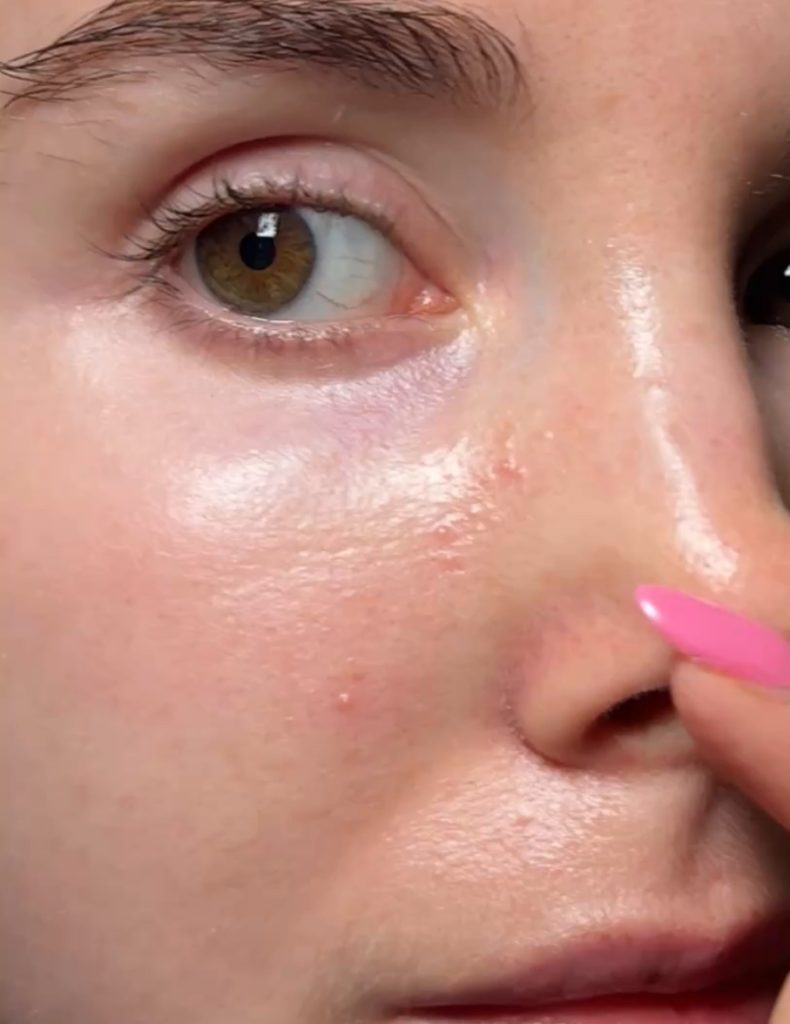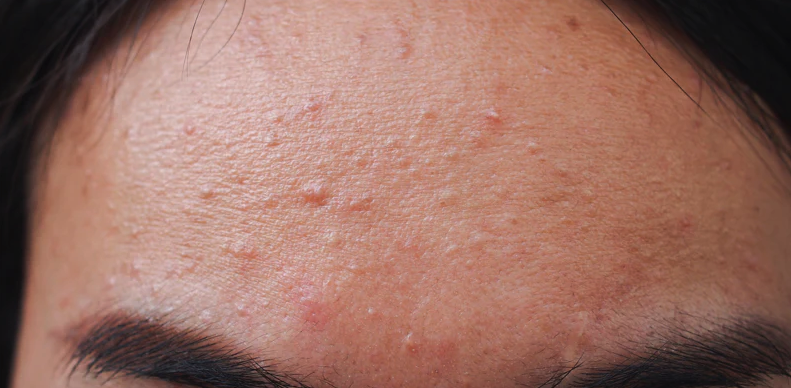This site contains affiliate links. I may earn a small commission, at no extra cost to you.
A lot of people think acne is just one thing, but in reality, there are several types – and each one needs to be treated a little differently.

The first step to clearing your skin is figuring out which type of acne you’re dealing with. And honestly, that process isn’t always as simple as looking in the mirror.
Fungal acne, for example, is less common but often resembles other types. So yes, that means that even if you think you’re dealing with hormonal breakouts, it may actually be fungal or both. It’s actually quite common – I deal with it every summer on my forehead.
In this post, I’ll walk you through how to tell if what you’re dealing with is fungal acne and what you can do to treat it.
How to know if you have fungal acne

Fungal acne is not only a bit difficult to diagnose, but it’s also difficult to treat. Bacterial acne, cystic acne, hormonal acne, and even inflammatory acne all generally improve with acne treatments like salicylic acid and azelaic acid.
But fungal acne? It won’t respond to typical treatments because those kill bacteria. That’s because bacteria isn’t the root issue of fungal acne . . . yeast is.
Let’s talk more about what fungal acne is and where it comes from:
What is fungal acne?

Fungal acne, also known as Malassezia folliculitis, isn’t actually acne. By definition, acne is caused by a combination of bacteria, hormones and sebum. With fungal acne, it’s got nothing to do with hormones.
Malassezia refers to the type of yeast that naturally lives on our skin – yes, we all have yeast on our skin. It’s normal and completely harmless. Not gross like it can sound!
That said, there are things that can trigger an overgrowth of yeast. The acne itself occurs when hair follicles are blocked by the yeast, trapping oil and dead skin cells inside.
Then the yeast feeds on the excess oil, causing inflammation and irritation, making the breakout worse and worse. This is why it looks like acne, but really it’s just inflammation in the pore.
That may all sound scary, but once you realise you have fungal acne, you can get the right product, kill the yeast, and see improvements overnight. It doesn’t take weeks and months to clear up like normal acne.
What causes fungal acne?
An overgrowth of yeast causes fungal acne, but how? Here are some things that disrupt your natural balance of yeast:
- Excess oil: Malassezia feeds on certain oils
- Oil-based products: Skincare products with oil can feed yeast, too
- Sweat and humidity: Warm, moist environments encourage yeast growth (like athlete’s foot and thrush!)
- Compromised skin barrier: Yeast can grow more easily without a strong moisture barrier
- Weakened immune system: Makes it harder for your body to keep yeast balanced
- Antibiotic overuse: Using an antibiotic can kill off beneficial bacteria that normally combat yeast, disrupting the microbiome
How to tell if you have fungal acne
Appears on the forehead, chest, back, and shoulders
Since sweat is often a contributing factor to fungal acne, it usually pops up on the forehead, chest, back, and shoulders most commonly.
Develops quickly
These breakouts can appear overnight and spread quickly under the right conditions (heat and humidity). Breakouts from true acne are usually more gradual.
Shows up as small, red or skin-colored bumps
Fungal acne bumps are usually uniform in size, which also distinguishes them from other types of acne.
They can resemble whiteheads or tiny, shiny pimples. However, most often, fungal acne will appear as red or skin-colored bumps on sweat-prone areas of the body.
Feels itchy or irritated
Sometimes, fungal acne itches. Bacterial acne can definitely be painful, but it’s rarely itchy the way a rash might be.
Fungal acne can also be irritated in the same way common acne types are. However, keep a close eye on any itchiness. If your acne feels itchy, you’re likely dealing with fungal acne.
Happens to teenagers and young adults
Fungal acne is more common in people 13-30. You have higher oil production at this time because of normal hormonal changes.
People of this age are usually more active, too, leading to increased sweating and a potential for fungal growth. Aside from this, other reasons can include a poor diet and inadequate skincare.
Fails to respond to typical acne treatments
As I said earlier, fungal acne won’t respond to standard acne treatments. Bacteria isn’t the problem. Scrubbing your face with cleansers and topical treatments to get rid of all the microbes on your skin won’t kill the yeast.
I know this process can become aggravating. Maybe you’ve tried creating an acne-fighting protocol using my post, “How to Create a Korean Skincare Routine for Acne-Prone Skin.” Or, maybe you’ve spent hours scouring TikTok for additional recommendations and advice. However, if you’ve tried everything you can and find that NOTHING works, your breakouts are likely fungal, not bacterial.
What does fungal acne look like?

- Small, uniform red bumps or pustules
- Often clustered together rather than scattered
- Typically the same size (unlike regular acne, which varies in size)
- Can resemble a rash or tiny whiteheads
- Usually appears on the forehead, chest, back, or shoulders
- May look shiny or inflamed
- Often accompanied by itching or irritation
- Spread quickly
- Gets worse in warm or humid weather
- Gets worse when you workout more, even though you use skincare religiously
How to get rid of fungal acne
Confirm it’s fungal acne, not closed comedones
Of course, the first step is making sure you truly have fungal acne. Remember, breakouts from fungal acne form small, itchy bumps on sweaty areas like your forehead and back.
Use Clever Soap: 0.5% Piroctone Olamine Cream 1-2x a day

My favorite product to treat fungal acne is Clever Soap .5% Piroctone Olamine Cream. It’s a topical antifungal cream that’s extremely effective. Clever Soap also sell it on their website if Amazon is sold out.
It works better than other remedies because it stays on your face all day or all night, constantly fighting yeast for fast results. Your breakout will likely be completely gone in a few days.
Try antifungal Nizoral shampoo

A common treatment for fungal acne is anti-dandruff shampoos like Nizoral or Head & Shoulders.
Both dandruff and fungal acne are caused by yeast, so the active ingredients should fix both. However, I’ve not had great results with this hack for long periods of time.
I think the problem is that, since it’s a shampoo, it rinses right off the affected area. This lets surviving yeast just start growing again. Piroctone olamine cream is a better choice because you leave it on, but if you have some antifungal shampoo, it doesn’t hurt to try it out.
Pair it with a retinoid or an exfoliant
When using an antifungal treatment, don’t stop using an exfoliant or retinoid. Each tackle different parts of the problem, getting you faster results.
The antifungal creams kill the yeast while the retinoid or exfoliant unclogs pores and prevents dead skin cell buildup that could be feeding yeast.
If you’re not using a retinoid already, check out my list of the best retinoids for clogged pores.
Talk to your GP about antifungal medications
When acne is persistent, there’s no shame in seeing a dermatologist or your GP. There are a lot of ways they can help.
There are both oral antifungal medications, like Fluconazole, and topical antifungal medications, like selenium sulfide and ketoconazole.
These will help get rid of your fungal acne fairly quickly. That said, you’ll probably develop it again if you don’t make the necessary lifestyle changes that prevent yeast growth. I am considering getting an air conditioning unit for the summer because the constant, low-level sweating in my London flat is the biggest trigger!
Avoid heavy creams or oil-based skincare products
The fatty acids, oils, and esters in heavy creams and oil-based products can be food sources for Malassezia. This can lead to an overgrowth of yeast and fungal acne.
Thick creams can also trap heat and moisture against the skin, encouraging even more growth. So, if you’re struggling with fungal acne, it’s best to go with lightweight creams and oil-free products.
Here are the best moisturisers for fungal acne, if you need recommendations.
Don’t use acne treatments that target bacteria
As I mentioned earlier, fungal acne won’t respond to acne treatments. Killing bacteria is not the goal – killing yeast is the goal, as well as making conditions less desirable for yeast (keeping cool, sweating less).
Put the acne-fighting products away while battling fungal acne, and focus instead on your piroctone olamine cream. That is your fungal acne treatment. Other ingredients that can work are zinc pyrithione, which is in some Head & Shoulders.
Be aware of humidity and sweating

Hot and humid environments will make you sweaty, prompting yeast growth. That means if you’re struggling with fungal acne, you should do what you can to avoid those conditions.
For a while, I was going to a gym without air con, and I noticed a flare up in fungal acne. I later switched to one that did have AC, and my skin looked much better.
So, switch up your gym; wear loose, breathable clothes; and use a handheld fan on hot days. Staying cool and preventing sweat from sitting on your skin will reduce your risk of fungal acne.
Don’t wear hats or anything across your forehead

Baseball caps, headbands, and any other accessory that applies compression or friction to your head are a bad idea.
A common side effect of wearing hats is the development of fungal acne on the forehead. Sweat, moisture, oils, and heat all become trapped under the band, creating the perfect conditions for yeast to thrive.
I struggled with this for a while, so I wrote a post specifically on how to get rid of fungal acne on your forehead.
Last resort: consider getting botox on trouble areas
If fungal acne becomes a consistent problem, Botox could be a possible solution. A lot of people don’t know this, but botox actually reduces sweating wherever it’s injected.
The forehead is a popular place to get Botox for good reason. It smooths wrinkles and lifts the brows while preventing excessive sweating. As a bonus, it also lowers your risk of developing fungal acne.
Botox is regularly used for hyperhydrosis (excess sweating) in places like the armpits, so it can work for your forehead too. However, I have heard that the sweat sometimes comes out of other places, like the top lip.
Wash your pillowcase regularly
Your pillowcase can be a breeding ground for bacteria and yeast. A satin or silk pillowcase will help some, as it’s cooler and prevents sweating, and it doesn’t absorb as much moisture from your face.
However, over time, oils, sweat, and skincare residue will still build up on the fabric. Washing your pillowcase regularly should help keep your skin balanced and healthy – free from fungal acne.
To treat fungal acne, you need to kill yeast, not bacteria.
It isn’t as difficult as it seems to diagnose fungal acne once you know what to look for. Always be mindful of the different acne types when treating your breakouts to ensure you’re using the right products and routines.
For more acne treatment help and skincare recommendations, follow me on TikTok and browse the rest of my blog. I also allow subscriber questions on Substack in the group chat.